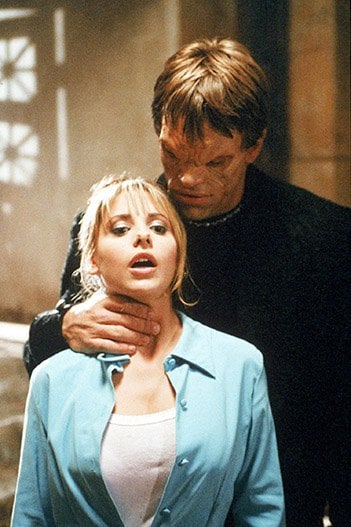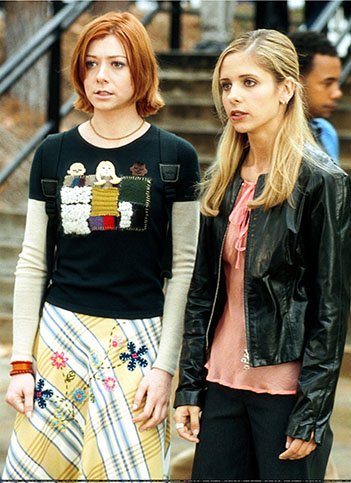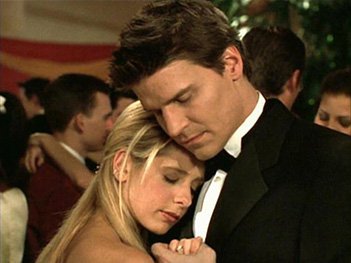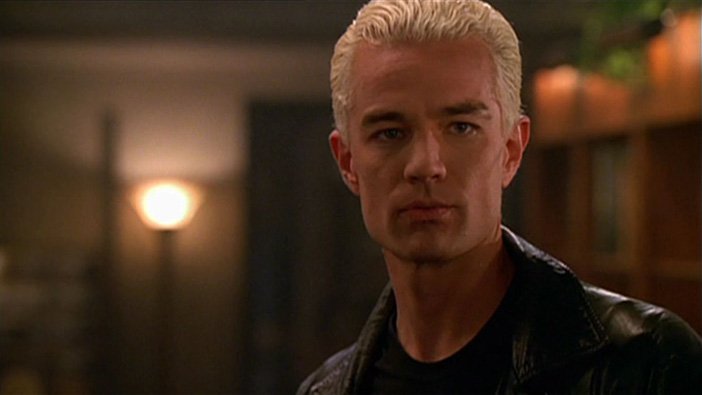Buffy: Binge On The Vampire Slayer
Buffy the Vampire Slayer is as good now as it ever was, and it’s one of the best TV series of all time. I’m sure ‘Breaking Bad’, ‘The Wire’ and ‘True Detective’ probably still surpass it in terms of sheer quality, but ‘Buffy’ has a scene where a peroxide-blonde punk vampire named Spike fights a monster with flaming fists in a battle for his soul. Those other series do not have that.

I know what you’re thinking – but I’m not honour-bound by nostalgia. The series certainly thrived throughout my days of pre-pubescence, but because of its well-documented Adult Themes and Scenes of Violence, my dear old mother decided to stamp a great big seal of ‘Unsuitable’ on it, preventing its Glory (read: the villain from Season 5) from being seen by my innocent eyes. It turns out she was sort of justified – I found out recently that the DVD boxsets have a great big ‘15’ certificate on them.
No, I properly ‘discovered’ Buffy late last January. Mostly exhausted, mostly unemployed and entirely bereft of anything I could do about either, I decided I’d collapse in upon my feelings of self-pity and binge-watch one of the many series I’d heard to be ‘unmissable’ for years. I suspected ‘The Wire’ would be too unsettling for this particular brand of melancholy so I opted for something I knew would have some kind of warmth, heroism and silliness to it – Buffy ended up being my brand of opium. 144 episodes, 7 seasons, two soulfully beautiful leather coats and one incredible journey later, I’m quite sure it’s my favourite television series ever.
Unlike many beloved series from the 1990s, Buffy actually ends up being a better show thanks to the Netflix Binge – while there are fillers and repetition, the show is self-aware enough to keep reeling you back in. It’s also so damn good that even the clichéd episodes are enough to demand your attention (the obligatory ‘Comedy Sidekick solo adventure’ is one of my favourite episodes of television). Binge-watching also adds to the fun of darting back-and-forth from the equally awesome leather-jacket-powered spinoff series ‘Angel’. Years before Samuel L. Jackson started assembling his own personal superhero boyband, Joss Whedon had already mastered the concept of comic-book crossovers in live-action with Buffy and Angel not only frequently showing up in each other’s shows, but driving the plots of them as well.
‘Buffy’ is a grand collaboration of all of my favourite genres. At its simplest, it’s a terrific superhero adventure series with a wonderfully crazy mythology and an inventive (if adorably cheap) aesthetic to match. Slightly beyond that, it’s a fun, juicy teen drama. Beyond that still it’s a clever inversion of genre tropes, a cunning experimentation of language (“I’m a bloodsucking fiend! Look at my outfit!”) and generally one of the best explorations I’ve encountered of a group of young characters as they become adults against increasingly complicated odds.

Show creator Joss Whedon’s primary goal with the series (and its ill-fated 1992 big-screen precursor starring Kristy Swanson and Luke Perry) was to turn the cliché of the hapless virginal blonde in horror movies on its head in a grand-scale thesis on female empowerment. Sarah Michelle Gellar plays the a-typical all-American cheerleader who just so happens to be the newest in a centuries-long line of Vampire Slayers prophesied to fight the hordes of demons and hellspawn that roam the Earth after hours. What follows is a mish-mash of typical 1990s teen drama angst and epic superheroism with Buffy aided by her best friends, the bookish teenage witch Willow (Alyson Hannigan before she helped Ted meet the mother) and the hapless Xander Harras played by the oft-forgotten Nicolas Brendon. Rounding out the cast is the secret weapon of the series, Anthony Stewart Head’s Rupert Giles, a mild-mannered sage with a dark streak of menace. Every character in the show ends the series in a drastically different place from where they began.
Typically, people remember the first three seasons of Buffy, where she and her friends attend Sunnydale High School and jump from monsters-of-the-week to larger arc-based threats like The Master or The Mayor, while enduring the melodrama of her on-again-off-again romance with good-again-evil-again vampire Angel (“Let’s make history…end” snarls the dreamy David Boreanaz). Seasons 1 and 2 are great fun altogether, while still occasionally victim to fillers and genre clichés. Season 3 is undoubtedly the most consistently brilliant and it represents the only point in the show’s history where every character in the opening credits was consistently interesting, every plot point was engaging and there were no forgettable filler episodes. The Zeppo, Band Candy, The Wish, Lover’s Walk, and the finale, ‘Graduation Day’ could have been a movie. This was the series at its most iconic.

The later seasons are a little bit more controversial – despite a few highlights, Season 4 is usually ranked fairly low in the hierarchy of the seasons – it’s a bit of a speedbump after the triumph of Season 3 and is unfortunately the dropoff point for a lot of people. Like many similar programmes, after high school everything seems a bit darker, a bit more complicated, a bit more painful and this type of storytelling can take time before it becomes interesting. With the vacuum left by series regulars Boreanaz and Charisma Carpenter’s unstoppably brilliant thunderbitch Cordelia (both of whom had migrated to the sister series), the show was left scrambling to find a new identity for itself. The addition of Spike (James Marsters, a man whose cheekbones can stop time) as a series regular was a huge success – the inclusion of Anya (Emma Caulfield – an actress apparently) less so. The series mercifully finds its feet again in Seasons 5 and 6, wherein the day-to-day problems of being in your twenties and trying to juggle a number of different opposing responsibilities (in Buffy’s case, managing her home and social lives while also trying to save the world) really take centre-stage. It’s a slower-burning series at this point, but this allows for some of the best character-heavy episodes, not least the all-singing, all-dancing ‘Once More with Feeling’ and the heartbreaking ‘The Body’. Season 7 is an anomaly among fans – some love it, some hate it, all generally agree that it was a missed opportunity with certain elements feeling rushed and others given too much attention. Personally, the series’ breakout character Spike is the reason why I can’t bring myself to dislike any of the later seasons. His particular evolution is among the best of its kind that I’ve encountered. He’s literally a better fictional character than Wolverine.

All in all, there aren’t enough reasons to recommend the series to anyone who’ll listen. Unlike so many of the relics of the past, Buffy triumphs now more than ever. It’s Freaks and Geeks meets Beverly Hills 90210 (with actors from both). It’s Wonder Woman meets Spider-Man meets Batman. It’s Interview with a Vampire meets Joan of Arc. It’s Dracula 1972 A.D. meets King Arthur. And by the sweet Goddess in the heavens does it have a better love story than Twilight (two of them actually). Take a month off work and treat yourself to a return to Sunnydale.
“It’s good for the soul”.

